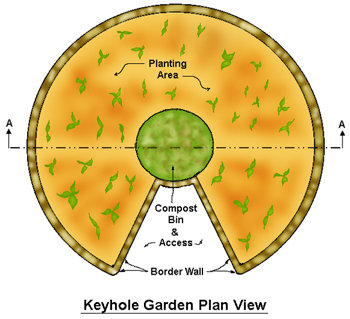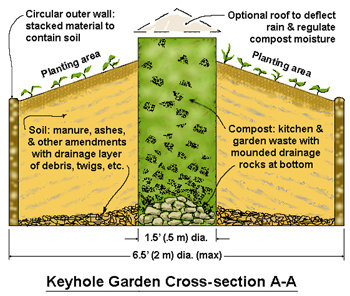Whose Crazy Idea Was This?The keyhole gardens are the brainchild of humanitarian charities and missionaries for use in impoverished countries with poor soil, bad weather, and starving people. At least one organization teaches the schoolchildren how to construct the gardens from available recycled materials and to care for the vegetables. The schools then have nutritious vegetables for lunches. The children are encouraged to build a keyhole garden at home to educate their parents, thus enabling families to feed themselves. Advisers visit with the families to trouble-shoot garden problems.
Keyhole Garden Concept
 The Keyhole Garden concept is brilliantly simple. A circular raised bed has a center compost basket that distributes nutrients to the surrounding lasagna-style garden bed. A small pie-slice section of the bed is used for easy access to the center compost basket forming the keyhole design (click the sketch on the left for larger image).
The Keyhole Garden concept is brilliantly simple. A circular raised bed has a center compost basket that distributes nutrients to the surrounding lasagna-style garden bed. A small pie-slice section of the bed is used for easy access to the center compost basket forming the keyhole design (click the sketch on the left for larger image).
Kitchen and garden waste, along with household gray water, are added to the center basket. The soil bed layers are slightly sloped away from the center to aid water and "compost tea" distribution. As the materials decompose, soil, composting materials, and amendments are added to the bed in later growing seasons.
Keyhole Garden Benefits
- Center compost basket provides a steady supply of plant nutrients and amendments
- Uses less water with mulching and moisture from center basket; drought-tolerance
- Depending on outer wall materials, soil can be warmer than traditional raised beds
- Garden can be modified per owner's needs, like child or handicap accessibility
- The short bed distance (from outer wall to center basket) is easy to tend
- Gardens require a small area, a maximum of 6-1/2' (2 meters) diameter
- Recycled material use makes the gardens inexpensive, or free, to build
- The raised design removes threat of trampling by pets and humans
- Saves steps by adding garden waste to the handy center compost basket
- Keyhole Gardens can be made temporary or permanent
- Keyhole Gardens can be an attractive feature with a good aesthetic design plan
Keyhole Garden Construction
 This is not a comprehensive how-to. If you would like detailed information to construct a Keyhole Garden, please follow the links provided at the end of this article, otherwise, refer to the Cross-section View A-A at left (click for a larger image).
This is not a comprehensive how-to. If you would like detailed information to construct a Keyhole Garden, please follow the links provided at the end of this article, otherwise, refer to the Cross-section View A-A at left (click for a larger image).
The following is a list of recurring points made for the garden design to work efficiently. Use whatever materials you may have at your disposal that will allow the best result to be achieved.
Materials:
- Drainage: Rocks, broken tiles or pots, rusty cans, twigs, small branches, or old critter bones can be used for the bottom drainage layer.
- Compost Basket: A tube, 1' to 1-1/2' (.5 meters) in diameter and tall enough to extend well above the center of the bed, can be fashioned from anything that will allow water to pass through into the surrounding bed like chicken wire, fencing, or sticks (think in terms of a woven basket). Supports to hold the basket in place, such as strong branches, boards, or rebar, and wire or strong twine to hold everything together, also, will be needed.
- Outer Border Walls: Anything that will contain the soil could be used: stones, bricks, or blocks can be stacked into place; boards or branches could be driven into the ground; sand bags or old tires could work as well.
- Planting Bed Fill: Use the same materials as for a lasagna garden, or compost pile, such as cardboard, paper, manure, leaves, straw, hay, old potting mix, or wood ashes, then finish the surface for planting with top soil.
Layout:
- A cleared level area no larger than 6-1/2' (2 meters) in diameter is the maximum size for a Keyhole Garden. A larger diameter bed may suffer from a lack of water near the outer wall of the bed (from the compost basket), and plants close to the center may be difficult to reach.
- The cutout area of the keyhole should be wide enough to allow easy access to the compost basket when adding materials, removing compost, or making basket repairs if needed. Positioning the cutout on the North side of the circular garden would use the dark space of the bed that would not receive full sun, thus leaving all the sunny sides for planting.
- All the layers added to the bed should slope downward to the outer border wall. The slope helps direct moisture from the compost basket out into the bed.
- The outer border wall can be as high as needed for the comfort of the gardener and the amount of sourced materials. The top surface of soil should stay below the outer walls to contain rainwater and prevent the soil from running off.
Other Considerations:
- A roof can be made to deflect excessive rain from the compost basket or to conserve compost moisture during drought.
- Trellises could be installed to support cloches for weather protection.
I have been gathering information and materials to construct a Keyhole Garden for a garden project next year. I was so excited by the design idea that I decided to share the information now, instead of waiting until I could build one to write about later. I hope I have provided a potential new garden concept for others to consider as well.
Additional Information
- Texas Co-op Power: Keyhole Gardening: Unlocking the secrets of drought-hardy gardening, by G. Elaine Aker; Issue: February 2012
- Valhalla Project: videos and photos
- Send-A-Cow: Keyhole Gardens and many other great frugal gardening ideas






 The Keyhole Garden concept is brilliantly simple. A circular raised bed has a center compost basket that distributes nutrients to the surrounding lasagna-style garden bed. A small pie-slice section of the bed is used for easy access to the center compost basket forming the keyhole design (click the sketch on the left for larger image).
The Keyhole Garden concept is brilliantly simple. A circular raised bed has a center compost basket that distributes nutrients to the surrounding lasagna-style garden bed. A small pie-slice section of the bed is used for easy access to the center compost basket forming the keyhole design (click the sketch on the left for larger image).  This is not a comprehensive how-to. If you would like detailed information to construct a Keyhole Garden, please follow the links provided at the end of this article, otherwise, refer to the Cross-section View A-A at left (click for a larger image).
This is not a comprehensive how-to. If you would like detailed information to construct a Keyhole Garden, please follow the links provided at the end of this article, otherwise, refer to the Cross-section View A-A at left (click for a larger image).